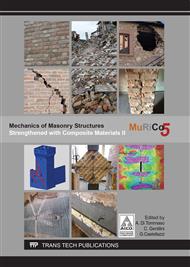[1]
S. Hashemi, R. Al-Mahaidi, Experimental and finite element analysis of flexural behavior of FRP-strengthened RC beams using cement-based adhesives, Constr. Build. Mater. 26 (2012), 268-273.
DOI: 10.1016/j.conbuildmat.2011.06.021
Google Scholar
[2]
C. Pellegrino, T. D'Antino, Experimental behaviour of existing precast prestressed reinforced concrete elements strengthened with cementitious composites, Compos Part B. 55 (2013), 31-40.
DOI: 10.1016/j.compositesb.2013.05.053
Google Scholar
[3]
L. Ombres, Structural performances of reinforced concrete beams strengthened in shear with a cement based fiber composite material, Compos Struct 122 (2015), 316-329.
DOI: 10.1016/j.compstruct.2014.11.059
Google Scholar
[4]
Z.C. Tetta, Bournas D. B, TRM vs. FRP jacketing in shear strengthening of concrete members subjected to high temperatures Compos Part B 106 (2016), 190-205.
DOI: 10.1016/j.compositesb.2016.09.026
Google Scholar
[5]
L. Ombres, S. Verre, Structural behavior of fabric reinforced cementitious matrix (FRCM) strengthened concrete columns under eccentric loading, Compos Part B 75 (2015), 235-249.
DOI: 10.1016/j.compositesb.2015.01.042
Google Scholar
[6]
C. G. Papanicolaou, T.C. Triantafillou, K. Karlos, M. Papathanasiou, Textile reinforced mortar (TRM) versus FRP as strengthening material of URM walls: in-plane cyclic loading, Mater Struct 40 (2007), 1081-1097.
DOI: 10.1617/s11527-006-9207-8
Google Scholar
[7]
G. De Felice, S. De Santis, L. Garmendia, B. Ghiassi, P. Larrinaga, P. B. Lourenco, D.V. Oliveira, F. Paolacci, C. G. Papanicolaou, Mortar-based systems for externally bonded strengthening of masonry, Mater and Struct 47 (2014), 2021-(2037).
DOI: 10.1617/s11527-014-0360-1
Google Scholar
[8]
L. A. Bisby, T. J. Stratford, E. C. Roy, M. Ward. Fibre reinforced cementitious matrix systems for fire-safe flexural strengthening of concrete: pilot testing at ambient temperatures. In Proc of Advanced Composites in Construction Conference (ACIC), NetComposites Ltd 2009: 449-460.
Google Scholar
[9]
A. D'Ambrisi, F. Focacci, R. Luciano, V. Alecci, M. De Stefano. Carbon-FRCM materials for structural upgrade of masonry arch road bridges. Compos Part B 75 (2015), 355-366.
DOI: 10.1016/j.compositesb.2015.01.024
Google Scholar
[10]
AC434. Acceptance criteria for masonry and concrete strengthening using fiber-reinforced cementitious matrix (FRCM) composite systems. ICC-Evaluation Service, Whittier, CA; (2013).
DOI: 10.14359/51702356
Google Scholar
[11]
AC549. 4R-13. Guide to design and construction of externally bonded fabric reinforcement cementitious matrix (FRCM) systems for repair and strengthening concrete and masonry structures. American Concrete Institute, Farmington Hills, MI; (2013).
DOI: 10.1016/j.prostr.2018.11.027
Google Scholar
[12]
F. G. Carozzi, C. Poggi, Mechanical properties and debonding strength of fabric reinforced cementitious matrix (FRCM) systems for masonry strengthening, Compos Part B 70 (2015), ; 215-230.
DOI: 10.1016/j.compositesb.2014.10.056
Google Scholar
[13]
T. D'Antino, C. G. Papanicolaou, Mechanical characterization of textile reinforced inorganic-matrix composites, Compos Part B, In Press. 10. 1016/j. compositesb. 2017. 02. 034.
Google Scholar
[14]
Contamine R, Si Larbi A, Hamelin P. Contribution to direct tensile testing of textile reinforced concrete (TRC) composites. Mater Sci and Eng A 528 (2011), 8589-8598.
DOI: 10.1016/j.msea.2011.08.009
Google Scholar
[15]
A. D'Ambrisi, L. Feo, F. Focacci, Bond-slip Relations for PBO-FRCM Materials Externally Bonded to Concrete, Compos: Part B. 43: 8 (2012), 2938-2949.
DOI: 10.1016/j.compositesb.2012.06.002
Google Scholar
[16]
C. Carloni, L.H. Sneed, T. D'Antino, Interfacial bond characteristics of fiber reinforced cementitious matrix for external strengthening of reinforced concrete members, FraMCoS-8, 2013, J.G.M. Van Mier, G. Ruiz, C. Andrade, R.C. Yu and X.X. Zhang (Eds).
Google Scholar
[17]
F. G. Carozzi, P. Colombi, G. Fava, C. Poggi, A cohesive interface crack model for the matrix–textile debonding in FRCM composites, Comp Struct 143 (2016), 230-241.
DOI: 10.1016/j.compstruct.2016.02.019
Google Scholar
[18]
L. Ascione, G. de Felice, S. De Santis, A qualification method for externally bonded fibre reinforced cementitious matrix (FRCM) strengthening systems, Compos Part B (78) 2015, 497-506.
DOI: 10.1016/j.compositesb.2015.03.079
Google Scholar
[19]
T. D'Antino, C. Carloni, L. H. Sneed, C. Pellegrino, Matrix-fiber Bond Behavior in PBO FRCM Composites: A Fracture Mechanics Approach, Eng Frac Mech 117 (2014), 94-111.
DOI: 10.1016/j.engfracmech.2014.01.011
Google Scholar
[20]
T. D'Antino, L. H. Sneed, C. Carloni, C. Pellegrino, Effect of the inherent eccentricity in single-lap direct-shear tests of PBO FRCM-concrete joints, Comp Struct 142 (2016), 117-129.
DOI: 10.1016/j.compstruct.2016.01.076
Google Scholar
[21]
L. H. Sneed, T. D'Antino, C. Carloni, C. Pellegrino, A comparison of the bond behavior of PBO-FRCM composites determined by double-lap and single-lap shear tests, Cement and Concr Comp 64 (2015), 37-48.
DOI: 10.1016/j.cemconcomp.2015.07.007
Google Scholar
[22]
F. Focacci, T. D'Antino, C. Carloni, L.H. Sneed, C. Pellegrino, An indirect method to calibrate the interfacial cohesive material law for FRCM-concrete joints, submitted to Materials and design.
DOI: 10.1016/j.matdes.2017.04.038
Google Scholar
[23]
T. D'Antino, L. H. Sneed, C. Carloni, C. Pellegrino, Bond behavior of the FRCM-concrete interface. In Proc XI int symp on Fiber Reinforced Polymers for reinf Concr Struct (FRPRCS11), Barros J, Sena-Cruz J Eds, (2013).
Google Scholar
[24]
UNI EN 1015-11, Methods of test for mortar for masonry – Part 11: determination of flexural and compressive strength of hardened mortar, Brussels, Belgium: Comité Européen de Normalisation, (2007).
DOI: 10.3403/01905442
Google Scholar
[25]
C. Carloni, S. Verre, L. H. Sneed, L. Ombres, Loading rate effect on the debonding phenomenon in fiber reinforced cementitious matrix-concrete joints, Compos Part B 108 (2017), 301-314.
DOI: 10.1016/j.compositesb.2016.09.087
Google Scholar
[26]
Sikadur®-30, Product Data Sheet, Edition 10/12/(2014).
Google Scholar
[27]
L. H. Sneed, T. D'Antino, C. Carloni, C. Pellegrino, A comparison of the bond behavior of PBO-FRCM composites determined by double-lap and single-lap shear tests, Cement and Concr Comp 64 (2015), 37-48.
DOI: 10.1016/j.cemconcomp.2015.07.007
Google Scholar


